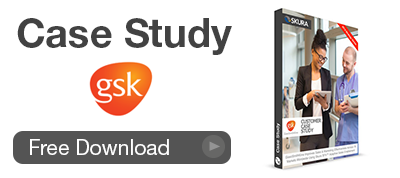Social media is an essential channel for marketing communications. B2B and B2C companies have been using social media to connect and communicate with customers and stakeholders for years.
However, many pharma sales and marketing teams have been hesitant to use social media in their communication strategies. Fear of FDA regulations, legal requirements and public engagement, have left many scared to enter the social media environment, and engage with patients and healthcare providers (HCPs).
Throughout this article we will be discussing why pharma companies should be using social media, the biggest challenges of social media for pharma sales, why pharma companies are afraid of social media, and several strategies for success!
[Related content] Our next post is an infographic explaining how using social media can benefit pharma companies.
Social media (SM) is an important medium of communication and an effective tool for achieving a variety of objectives. This is especially true for the pharma industry, where current trends (declining access and trust) are making it increasingly difficult for pharma sales reps to engage with HCPs.
Only half of the world’s largest pharmaceutical companies use social media (Source: FiercePharma, 2014).
The rise of SM has positive implications for pharma sales and marketing:
 (Statistic Source: Act-On, 2015)
(Statistic Source: Act-On, 2015)
Why Should Pharma Companies Use Social Media?
It is estimated that 2.078 billion people worldwide are active social network users. With millions of unique users logging into Facebook (1,366 M), Twitter (284M), and LinkedIn (396M) (Source: We are Social, 2015).
In regards to social media’s effectiveness for marketing efforts, 92% of marketers surveyed ‘strongly’ or ‘somewhat agree’ that SM is important for their business.
- 58% strongly agree
- 34% somewhat agree
And most importantly, 72.6% of sales people using SM outperformed those who weren’t (Source: Act-On, 2015).
The greatest benefit of using social media for pharma is that it levels out the playing field of communications among companies. In the SM world the biggest brain often overshadows the biggest bank account, as users reward interesting, entertaining, or insightful content, and disapprove of blatant selling and promotions.
SM is an excellent platform for pharma companies to create awareness about diseases and treatments, build brand awareness, clinical trial enrolment, patient support programmes, etc. (Source: ABPI, 2013).
Pharma digital marketing teams can participate and connect with their target markets in real time. They can increase their credibility, improve their authenticity (here is an infographic that we made explaining why healthcare providers want authenticity from their pharma sales reps), make connections, and even earn new leads.
For example, potential leads may stumble upon, learn about, and engage with your brand on SM, eventually leading them to your site and interacting with one of your pharma sales reps. Therefore, increasing brand awareness and potential sales.
Many patients are turning to social media sites for treatment suggestions, emotional support, and to make connections with the companies that impact their daily lives. More than 40% of consumers say that information that they found on social media affects the way that they deal with their health (Source: Mediabistro). Pharma companies must be present and involved!
 (Stat Source: Digital Insights Group, 2014)
(Stat Source: Digital Insights Group, 2014)
What are the Biggest Challenges of Using Social Media?
1. Creating and Using Social Media Guidelines
Due to the nature of the pharmaceutical and healthcare industry it is important that companies create social media guidelines for their employees - dictating what they can and cannot post. Consideration should be paid to company values, public expectations, as well as legal and policy requirements. This allows pharma companies to have some control over the SM process (Source: Pharmaguapa, 2013).
63.5% of respondents, (including consumer advocates, PSRs, and HCPs), stated that they believe that each company should have a public SM policy that includes a notice of transparency (Source: Pharma Marketing News, 2010). Lack of transparency and disclosure makes the industry appear untrustworthy in the eyes of consumers.
The legal department and upper management must approve the guidelines, and then communicate them broadly both internally and externally. Companies should ensure that all pharma sales and marketing staff involved in SM receive the appropriate training.
Appropriate permissions and disclaimers should be present, as well as terms and conditions for information use. ABPI has written guidance notes on the management of adverse events and product complaints from digital media.
2. Content Creation
The challenge of successfully utilizing SM occurs when establishing multi-channel communication and marketing practices for content creation.
Many marketers simply opt to format existing content from their other channels for SM. However, recycling old content without adding value, or adapting the voice to match the platform, is frowned upon by SM users, and will reduce a pharma company’s online credibility.
3. Listening to Users
Social media is the direct-to-consumer channel that pharma should pay attention to. With the percentage of accessible HCPs dropping below 50% as of 2015, PSRs must seek new opportunities for engaging customers (Source: ZS Associates, 2015).

Listening to opinion leaders in the industry about their wants and needs can also help pharma to stay competitive.
It is important to note that pharma digital marketing teams should ensure that user-generated comments and content are highly supervised to prevent the spreading of harmful or false medical information or advice (Source: ABPI, 2013).
4. Being Social
The biggest challenge of SM for pharma sales? Being social!
SM interactions require responsive and personable engagement. Pharma companies must engage in two-way conversations with users, adding value, and providing help whenever possible. They should always strive to be transparent in their interactions.
Social media managers for large pharmaceutical companies will have to be information gurus as they may be asked a variety of questions about their products and services, and will have to respond quickly with valuable insights.
Why are Pharma Companies Afraid of Using Social Media?
Pharma companies have been afraid of using social media for many reasons, including:
- Fear of regulatory compliance;
- Legal issues and violations;
- Misinterpreted advice; and
- Publicized product complaints
Regulatory constraints are the most common argument from pharma against using SM, however this pushback is a moot point. The FDA rarely raises concerns about the use of SM by pharma companies (Source: Pharmaguapa, 2013). The infamous Novartis Pharmaceutical letter represents an exception, not the rule, and the violations were easily rectifiable (Source: Corporate Compliance Insights, 2013).
Although more pharma companies are beginning to create SM accounts they are limiting the amount of engagement allowed by the public. Preventing users from posting misinterpreted advice and disallowing publicized product complaints.
For example, they may create a Facebook page for sharing owned content, but block public posting. Restricting engagement guarantees control over the conversation at the high cost of making other users feel disconnected and unheard (Source: Pharmaguapa, 2013).
Rather than worrying with about these problems, pharma companies should instead be concerned about the potential downsides of not embracing SM. The long-term consequences of alienating social business practices will only hinder the life science industry (Source: STweM, 2013).
Social Media Strategies
Objectives are a necessary tool for any SM strategy. Setting SMART (specific, measurable, achievable, realistic, time-bound) objectives, and measuring/monitoring results is important. By determining what works and what doesn’t, marketers can revaluate and construct better plans for the future.

An integrated SM communications strategy, with an actionable delivery strategy, that aligns departments and break sdown silos is essential for SM success. The overall strategy must be in line with company goals.
A well-trained, cross-functional team is essential for effective SM interactions. This means pulling together minds from different departments and delivering a multifaceted approach to customer communications. Everyone on a team must know what is expected from the SM engagement, and how to react in any interaction.
The growth of social media is heavily influencing multi-channel changes. Pharma marketing teams should use a digital content strategy in conjunction with a marketing automation platform to adjust for changing patient and payer preferences and channels.
This is the outcome we delivered to GSK through our adaptive sales enablement program. PSRs are able to engage HCPs through a channel and time frame that worked for everyone involved. The backend data and comprehensive analytics from these exchanges informed the content team about the kind of material they should be creating in order to add value and invite further engagement from HCPs. Download our whitepaper below to learn more.
Pharma should be listening to customer’s input, sharing relevant content that is meaningful to stakeholders, avoiding self-promotion, and participating with the goal of adding value and solving problems.
Providing useful (non-promotional) resources is the best way for a pharma company to improve authenticity and add credibility. This is especially important when you consider that 75% of HCPs do not currently trust the information provided to them by PSRs (Source: Deloitte, 2015).
Conclusions
Social media is now inseparable from conversations about public health awareness and information. It is too important for the industry’s voice to be absent, especially when they can add value, and correct uninformed opinions to improve patient outcomes and health.
Despite the potential headaches, and unknowns of social media involvement, pharma must take the leap! They can be proactive by building trust with consumers, combatting myths about their products, and effectively handling product complaints. All of which improves their image in the minds of consumers.
More Information on Pharma and Social Media
Our next post is an infographic explaining how using social media can benefit pharma companies.
Subscribe to our mailing list for an instant notification when new articles are released, and follow us on Twitter, LinkedIn, and Facebook for more sales and marketing insights.
Request a demo below and let our sales specialists show you how a sales enablement solution can help you with your social media and integrated marketing communications strategy.













